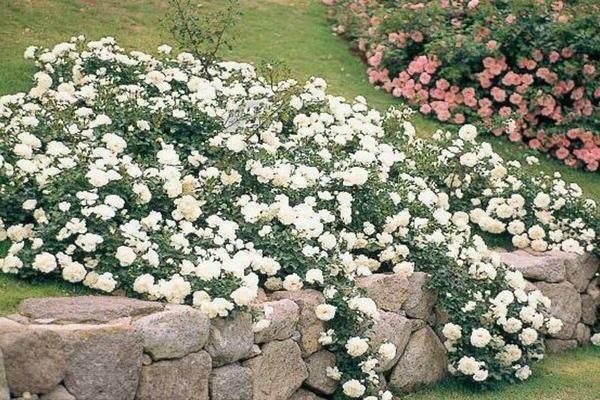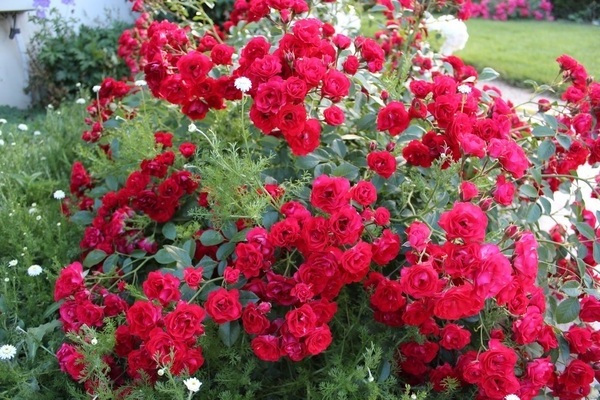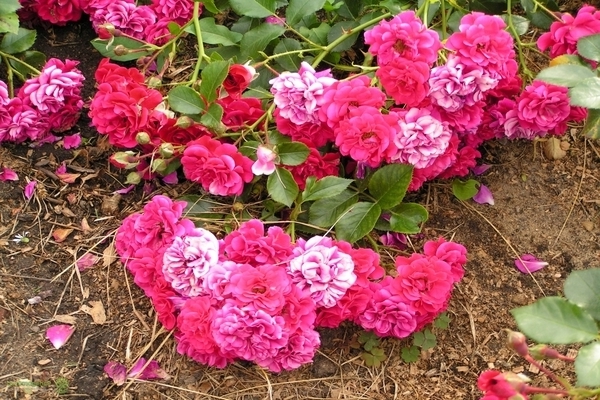Ground cover roses planting, care, varieties with photos
Content:
Ground cover roses: characteristics

Ground cover roses
Ground cover roses are a group of varieties that ranks first in the variety of shapes and types of flowers. They can be of different heights, from just a few centimeters to one meter. Stems of low varieties can spread over the surface, or tall, gracefully bending to the ground. Their buds can be like velvet or have a smooth surface, while not inferior to the first.
The flowers of this group are so diverse that surely anyone can find a rose to their liking. However, despite their differences, they have something that connects them. This long, rich flowering delights with a riot of colors and its uniqueness. It lasts from the beginning of summer and, for some, until mid-autumn. Some varieties of these roses are highly frost-resistant, resistant to many diseases and pests, can grow up to one and a half meters wide and their shoots are covered with many small glossy leaves.
Ground cover roses: choosing a place

Groundcover roses prefer to grow in partial shade with plenty of sunlight throughout the day. By providing the plant with light, we can enjoy flowering for several months. Please note that you should not plant flowers in open, sunny areas, as this can harm it and cause a burn. It is also not worth planting in the shade, in such places the roses begin to hurt and die, or bloom very weakly. A good option would be to land your beauties in the southeast or west. There they will be able to fully enjoy the sun until the heat of the day, from which trees or bushes will be able to protect.
When planting your plants in the garden, note that this must be done at a slight angle and on a hillock of about 40 centimeters, so that excess water can drain off during heavy rains and melting snow. When planting on a hillock, you can also be sure that the sun will be enough for the flowers.
It is important to know that roses of this group do not like too much moisture in the soil, this can cause fungal diseases, and in winter the roots can freeze out. They also do not tolerate soils with a high level of acidity.
Time to board
Planting time in autumn or spring, depending on the region. For residents of the southern regions of the country, it is better to do this in the fall, so that the young developing root system is not damaged by the scorching sun. In regions with harsh winters, planting should be done in the spring after the ground has warmed up. This is usually mid-May. When planting a plant in the fall, the shoots should only be cut a little. In the spring, when the main pruning is done, 3 buds should be left strong, and no more than two weakened.
How to properly prepare a landing site

Considering the fact that ground cover roses have stems low down to the ground or creeping along it, weeding them can be extremely difficult. Therefore, before planting them in the garden, weed the area well, removing all weeds and roots. To significantly reduce the appearance of weeds, after weeding, it will not be superfluous to treat the land with a non-selective systemic herbicide, which can be purchased at any specialty store or nursery. After processing, the land must be loosened.The use of mulch will help protect the land from the treachery of weeds and make it easier for yourself to care. It can be made with sawdust, hay or bark about 4 centimeters thick. This not only protects against unnecessary overgrowth of harmful grass, but also helps to retain moisture in the soil.
The soils of these roses love fertile, loose, low acidity (up to 6.5 pH) and well-drained. If your garden has predominantly sandy soils, then they must be diluted with a mixture of clay and humus. By planting a plant in unprepared sandy soil, you expose it to overheating in summer and freezing during cold weather. In addition, the flowers will not be able to demonstrate their splendor to you during flowering, since they will not receive the necessary nutrients from such soil.
Ground cover roses: planting
After the soil is cleaned and prepared, it is necessary to make holes to a depth of about 70 centimeters, depending on the length of the roots, adding another 20 centimeters. The hole should be 50 centimeters in diameter. If you decide to plant many plants of this group at once, then you can make a trench. When the seedling is placed, the hole is slowly filled with soil and watered at the same time, this will help prevent voids. After that, the soil must be gently tamped with your hands, watered well and hilled. When young shoots grow up to 5 centimeters, the ground around the plant is covered with mulch. Observe the distances when planting, as ground cover roses grow well in width. It will be sufficient for 1 sq. meter to plant no more than three seedlings.
Care: watering and feeding
Groundcover roses are not a very demanding plant and caring for it is not very different from caring for other varieties. This plant is loved by gardeners not only for its beauty, but also for the fact that it will not deprive you of the opportunity to enjoy its beauty if you do something wrong. The most important thing for her is watering and fertilizing, if necessary.
Groundcover roses: watering
Watering rose bushes should be regularly and only in the absence of the sun. The best time is early morning or evening. The fact is that falling water droplets on the leaves, during the period when the sun shines on them, can lead to burns. The same applies to fertilization. Remember that this plant is moisture-loving, but does not tolerate excess moisture. Before watering, dip your finger into the soil 4 centimeters, if the ground is dry, then proceed. With the onset of autumn, it is necessary to gradually reduce watering until it stops completely. This method will help the flowers calmly go into a state of rest.
Top dressing
Caring for roses means feeding them. During the period of their growth, fertilizers can be applied three times. The first time this is done in the spring, 14 days after the first leaves bloom. Complex mineral fertilizers containing nitrogen, phosphorus and potassium are perfect for this. They can be purchased in nurseries or specialized stores, after consulting with a specialist. Top dressing should be done according to the instructions on the package.
Fertilizers are applied for the second time in a month. Please note that you cannot make them when the bushes begin to bloom. If your plant blooms twice a season, then you need to feed it after the first flowering ends. In this case, the old buds are removed.
The third time fertilization is applied in the fall. This time they should be potassium based, which will promote good stem development.
Pruning
Groundcover varieties are distinguished by the fact that they do not need to be pruned every year. This is a nice fact, as maintenance becomes much easier. Moreover, most flower growers prefer not to prune at all, allowing the plants to retain their natural forms. Moreover, their flowering on older shoots is no worse than on young ones. The main thing when planting plants is to observe the distances so that they are comfortable.
How to protect ground cover roses in frost
Not all varieties of this group are able to withstand frosts without shelter. Those that are of small stature, as a rule, do not need it, as they are covered with a blanket of snow. However, if there is little snow or the bushes are tall, then you should take care of them and cover them with non-woven material. A good option would be to make a small structure and pull the covering material over it. The stems of tall plants must be bent to the ground by placing them on spruce or pine branches. After that, they must be covered either using spruce or pine branches, or covered with a heat-retaining material.
Reproduction
Propagation of ground cover varieties occurs using cuttings or layering.
The easiest way among gardeners is considered to be layering. In this case, you need to take one shoot, press it to the ground, sprinkle it with soil and put a small load on top. This should be done in the spring and throughout the summer months, watering, not allowing the soil to dry out. Having given it to overwinter in this position, in the spring, separate it from the mother plant and transplant it into a permanent residence.
Application in design
Groundcover roses are highly prized among landscape designers for their variety of colors and shapes. These flowers can be used to create flower beds, decorate walls, rocky areas, garden paths or slopes with them. These spectacular, graceful, incredibly beautiful flowers can decorate any corner of your garden and home.
The most popular varieties of ground cover roses among gardeners
Faerie

It is a creeping rose variety. It is unpretentious, does not require feeding, pruning and is resistant to sudden changes in the weather. Can be planted in the shade. Fairy is highly resistant to various diseases, pests and frost. With it, you can decorate your site in a very original way. The height of the bush does not exceed 80 centimeters. The leaves are dark green and shiny.
Swany

The bush of this variety is spreading. The width of this plant reaches one and a half centimeters. Height no more than 70 cm. Abundant and long flowering. Its velvety white flowers have a delicate pink tint at the very center. Shapes resemble a rosette. Swanee has good immunity against diseases such as powdery mildew.
Scarlet

The flowers of this variety are the owners of an incredibly beautiful deep red color and delicate aroma. The shape of the flower resembles a bowl containing 45 petals. Scarlet is considered a tall plant, its height reaches one and a half meters. Rarely sick, resistant to pests and cold.
Super doroti

The flowers of this variety are pink, their diameter can reach 3 centimeters. The bush grows no more than 70 centimeters. Their mustaches can be forgiven 2.5 meters.
Hello

These are velvety flowers of a dark red color, which change their hue to dark crimson at the end of flowering. The flower is 6 centimeters in diameter and contains 120 beautiful petals. A shrub of low growth up to 50 centimeters in height. Resistant to frost down to -30 degrees.

